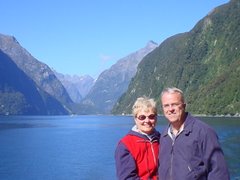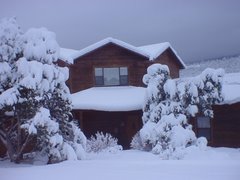Weather was an obstacle: snow and ice in TX and OK, not to mention in Cedar Crest. I had planned to leave Saturday, but road reports on I-40 across OK made me delay it until Sunday. Late Sat. night the reports said just occasional slick spots on bridges and overpasses, so I decided to go for it. (Turned out that highways were clear for my whole trip.)
Left at 5am, got to Amarillo for Waffle House brunch. You have probably seen the Cadillac Ranch west of Amarillo -- a line of Cadillacs buried nose down. Here's a picture.

I didn't stop there, but east of Amarillo, as I exited for a Love's station, I came across this low-budget approximation -- Volkswagen Farm?

Up to this point it had been a clear day, but just down the road fog set in and persisted for most of the rest of the way to OKC.
The trees along the road were lightly ice-coated, not enough to break limbs as was the case in southern OK. I exited a couple of times to try to capture these ghostly trees. This doesn't quite do it, but maybe you get the idea.

And I did see a photo-worthy barn.

Got to my sister, Connie's, in Edmond in late afternoon. Connie, Verla, and I visited Mom in her assisted living quarters and had dinner afterwards -- chicken-fried steak sandwich the size of a Frisbee, in case you're wondering.
Monday morning, off to Tonkawa, which is about 90 miles north of Edmond, along I-35. Took a quick drive around town and stopped at the High School and had a short, informative visit with the Principal. Lots of changes to the building since 1960. Seven of us classmates then met and did some reunion planning. We're the Class of 1960; reunion to be next fall at Homecoming time.
I didn't take any Tonkawa pictures, but here's a historical one -- taken the day of our graduation, I think.

And here's the train station, since restored.

I left Tonkawa in early afternoon and drove mostly straight west about 3.5 hrs. to Laverne. This was a nostalgic drive, first along US 60, then US 64 -- the route we often drove from Tonkawa to see grandparents and other relatives in NW OK, from whence both of my parents came. I remember narrow bridges (when I was learning to drive) across small creeks and they're still there. Small towns, about 15 miles apart: Lamont, Pond Creek, Nash, Jet, Cherokee, Alva, ..., Buffalo. Lots of abandoned houses and businesses along the highway -- were they bustling towns 50 years ago? Still, these towns give me an impression of something solid -- people came and set down roots, survived and thrived, at least for a while.
Had dinner (Frito pie, pecan pie) and spent the night with Ross and Marsha. Only downer was watching OSU on TV losing a basketball game to Texas on the hallowed floor of Gallagher-Iba Arena. Which reminds me. There used to be an OSU display in the Love Field terminal in Dallas that proclaimed: "Oklahoma State University. A Brighter Orange!" The OSU colors are (bright) orange and black. TX is burnt (dull) orange. Get the message? I thought that was clever and always wanted to compliment whoever in Public Relations came up with it. However, I did worry that UT folks wouldn't understand it. Alas, the display is no longer there, so maybe one of them did get the point and complained.
Ross was a Navy pilot, flying missions over Vietnam (five different planes off five different aircraft carriers). In 1966 he was shot down and heroically rescued by a helicopter crew. Amazing story. He's got lots of pictures and videos from that time.
Tuesday morning I headed home. Here are some scenes:
The windmill museum in Shattuck, OK:

A tree, still ice-covered. This must be the first sunshine since the storm.

The Land.

I had hoped to rendezvous with our friends, Roy and Sue Sooter, in Amarillo for lunch, but they weren't home when I called, so I ended up stopping in Canadian, TX for lunch and a history break. What snagged me was a sign proclaiming: Historic Wagon Bridge Across the Canadian River. Here it is:

The bridge is 3255 ft. long (.6 mi.), 16 ft. wide, and has 21 trusses (arches) -- it was the longest bridge of its type in TX when it was built. I walked over and back for my day's exercise. The bridge was built in 1916 and in use until 1953. It was nicely restored for pedestrians and bicycles (the sign said, but you can see ATV tracks in the pictures) in 2000.

After all that exercise I chowed down on barbecue in the Cattle Exchange restaurant in downtown Canadian. Bread pudding for dessert included in the meal. Canadian is the hometown of friend, Carrie Eaton, so I tried to send her a text message, via Donna Eaton, from there.
From there it was on to Amarillo and I-40 and home. Wouldn't you know, about a half-hour past Amarillo I heard from Roy Sooter. They had been out all morning and he didn't have his cell phone with him, so they had just gotten my message. Next time.
Along the way I listened to two recorded books that I think are worthy of mention.
1. On 'The Wealth of Nations,' by P. J. O'Rourke. 'The Wealth of Nations,' by Adam Smith, a Scotsman, is a 900 page treatise on economics published in 1776. It's often cited and not often read by the layperson, as you can imagine. O'Rourke gives you a humorous, mostly understandable rendering of Smith's book with lots of current references and allegories. One that comes to mind is your friend's dog who has a carnal attraction to your leg, but I can't remember what point that illustrated.) O'Rourke skewers politicians and economists across the whole spectrum, as well as Smith for his sometimes obtuse, sometimes self-contradictory passages. But, he also finds and appreciates Smith's sense of humor and sarcasm in some areas (which is maybe why he undertook this project). Smith's underlying theme is: Wealth depends on the division of labor (different people do different things). The division of labor depends on trade (everybody finds, or strives to find, a market for what they do). Trade depends on freedom. Thus, Freedom = Wealth. But, of course regulations, taxes, laws, and politics all enter into the equation. So, Smith discusses the proper and improper roles for all of these aspects of an economy. When you're listening to this, sentences go by that you would like to pause and think about, but you can't. So, I think I'll check out the book and read it some time.
Ross, Marsha, and I had a discussion about wealth-production in the current global economy that touched on these issues. I'm sure Adam Smith and P. J. O'Rourke could have helped us. I couldn't.
2. Wild Trees, by Richard Preston. This is about tall trees, primarily the California redwoods, and the people who study them and climb in them. It's more about the people than the trees, but both are fascinating. Some unusual people are drawn to explore trees. Can you imagine climbing into the canopy of a redwood tree 350 ft. off the ground? If you've followed our reports from New Zealand to California, you know we tend to stop for big trees, so that's why this book got my attention.
Got home around 6pm. Just in time, too, because it snowed all the next day, Wednesday. Here's my almosthomeshotthroughthewindshield picture.

Where was Susie? you might ask, as did several of the people I visited. Well, she just thought this was the kind of trip I might like to take by myself, so she graciously let me. (In between educational book passages I played bluegrass and country gospel music real loud.) She spent two nights with her son, Matt, and family in Rio Rancho, and kept a couple of appointments she had. However, I'm sure she'll want to read some Adam Smith soon.
So, it was a fast, enjoyable three days mostly on the road.
Cheers,
Rob






